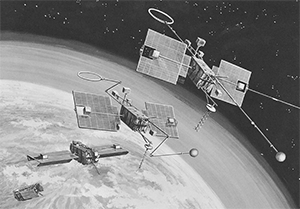Orbiting Geophysical Observatory Series
Orbiting Geophysical Observatory Series

An artist's impression of an OGO satellite. (Credit: NASA)

Artist's impression of the deployment of an OGO satellite. (Credit: NASA)
The Orbiting Geophysical Observatories was a series of six satellites launched between 1964 and 1969. They were intended to study the Earth's atmosphere, magnetosphere, and the space between Earth and the Moon. Prior to the OGO satellites, NASA had tailored each satellite to the instruments and experiments that particular satellite would carry. OGO was different in that the satellite design was fixed and experiments would need to be engineered to fit the satellite. Each satellite carried about 20 experiments. OGO-1, OGO-3, and OGO-5 each carried instruments that produced results for high-energy astronomy.
Lifetime: September 1964 (first launch, OGO-1) - March 1972 (last satellite, OSO-6, ceases operation)
Country (primary): United States
Primary Science
The OSO satellites were designed to study the Sun in ultraviolet and X-ray light through an 11-year cycle. In particular, they were designed to measure the solar electromagnetic radiation ultraviolet, X-ray and gamma ray.
Science Highlights
- Evidence of one or more gamma-ray bursts were found in the historic data, after GRBs were discovered.
- Detection of highest intensity to date of high-energy X-rays from a solar flare.
Links to more information
OGO-1
Lifetime: September 1964 - November 1969
OGO-3
Lifetime: June 1966 - December 1969
OGO-5
Lifetime: March 1968 - July 1972

